Refining Flux
About This Project
Refining Flux from AdTech is dedicated to research and development, production, and marketing of refining flux for degassing and deslagging in molten metal during aluminium alloy casting process. AdTech’s refining flux utilizes unique technology to enhance the traditional degassing and deslagging effect, and this technology applies to the casting process of multi-series aluminum alloy products such as micron-sized aluminum foil, PS baseboard for printing, canning material, elastic packaging material, railway transportation, aerospace products, cable & wire and other casting aluminum purifying.
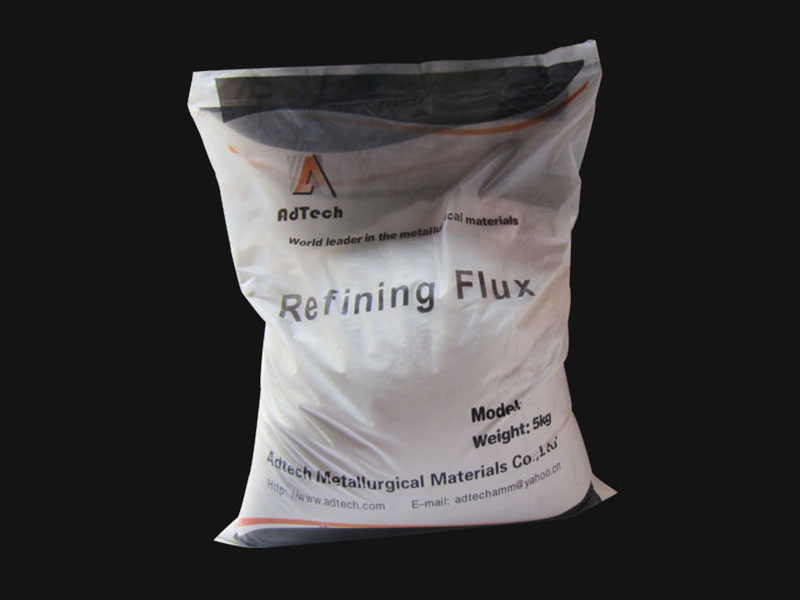
3RF,6RF,9RF,420RF,560RF,33SF,66SF,120SF,220SF
Assembles of Refining Flux:
- Refining Flux
- Refining Jar
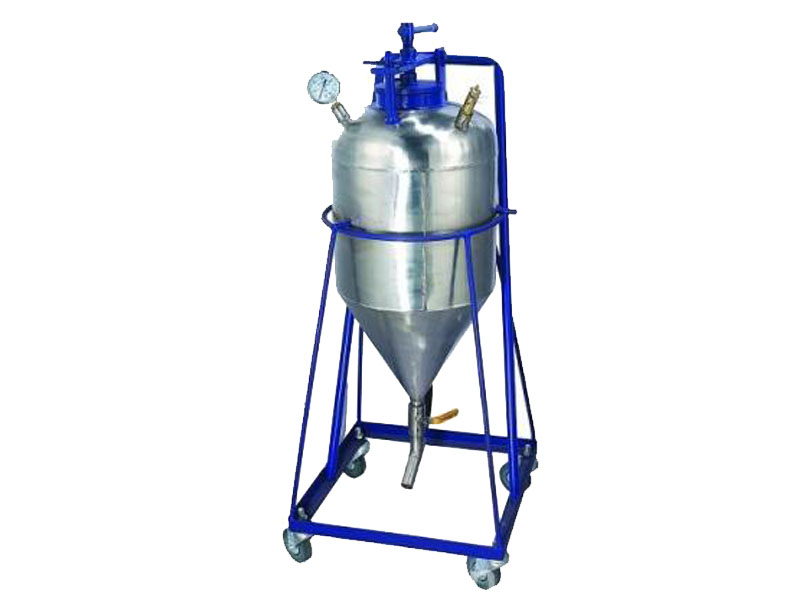
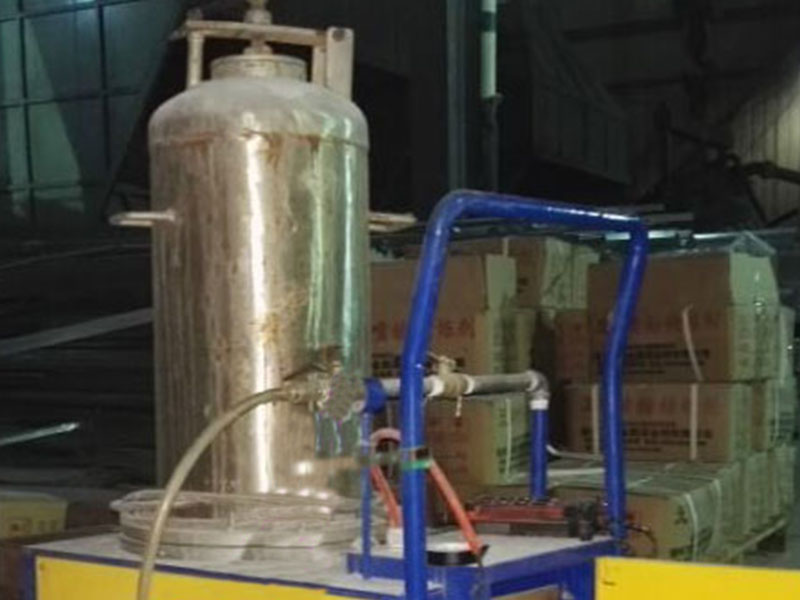
Applications for refining flux:
AdTech’s refining flux is white with slightly gray powdery fine particles. The main ingredients are chloride and villiaumite, together with other compounds. After appropriate heat treatment and screening, it turns to uniform size, which is conducive for transferring in a refining jar with(N2 or Ar) gas as a carrier to the bottom layer of molten aluminum. Through physical and chemical changes in the molten aluminum, numerous small bubbles are formed and fully in contact with molten aluminum, separating hydrogen and other harmful gases. At the same time, adsorbing and fusing compounds contained in the refining flux can strongly adsorbing and fusing oxide and float, attaching together to the bubbles, with the rise of the bubbles and being brought to the surface of molten aluminum, so as to achieve the degassing and deslagging purpose of purification. Both environmentally friendly and economically, purifying with AdTech’s refining flux meets the requirement of high value-added & high-tech performance aviation, transportation, and other aluminum alloy precise casting production, such as computer hard drive, micron-sized aluminum foil raw material, PS baseboard for printing, canning materials, fan blades for turbojet engine, etc.
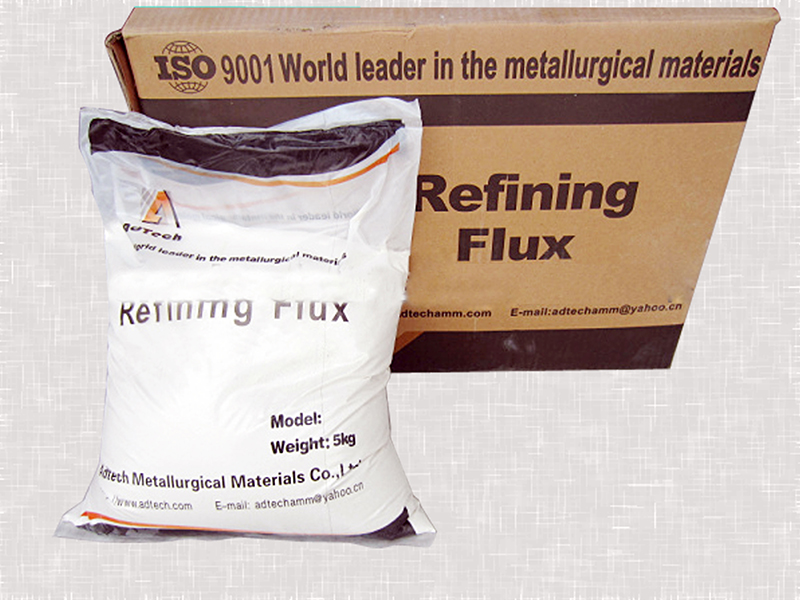
Advantages of Refining Flux
- AdTech’s refining flux uses molten metal compounding combination principles researching, developing, and configuring products. Reducing smoke, depressing burning wastage which protects the environment economically.
- AdTech’s refining flux solves the problem of traditional massive dosage and ash output refining effect. The dosage of AdTech’s refining flux is 1.5-2.0kg per ton, with ash output of 0.8-1%, fulfilling high-precision aluminum alloy casting requirement, effectively improving the molten metal yield rate of 0.6-0.8%, achieving energy-saving purposes.
- AdTech’s refining flux with appropriate heat treatment and screening, turns to a uniform size, which is conducive for transferring in a refining jar with(N2 or Ar) gas as a carrier to the bottom layer of molten aluminum, which fully solves the traditional problem of tube plugging, failure to uniformly dispersing to ensure quality casting.
The efficiency of refining flux using 6063 alloy
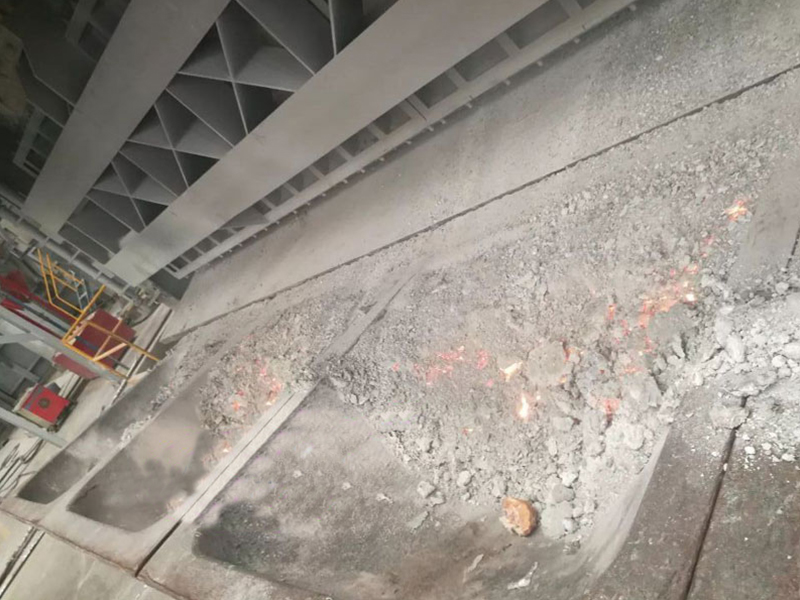
Standard refining flux type
| Type | Function | Scope of Application | Dosage per ton | Refining temperature |
| 3RF | Degassing & Deslagging | Molten casting aluminum and alloy degassing, deslagging & purifying | 1.5-2.5kg | 700- 740℃ |
| 6RF | Degassing & Deslagging, better than 3RF | Refining of cable rod and alloy rod precise casting | s1.0-1.5kg | 700- 740℃ |
| 9RF | Environmental, without C2Cl6 | Refining of high purity & high magnesium molten alloy in furnace | 1.5-2.0kg | 700- 740℃ |
| 420RF | Degassing type | Refining and purifying of highly precise aluminum, such as A356.2 and hub | 1 .5-2. 5kg | 710 – 730℃ |
| 560RF | Na free type, Degassing & Deslagging | Refining and purifying of 5 series aluminum alloy and hub in the furnace | 1. 5-2.0kg | 720 – 740℃ |
| 33SF | Degassing & Deslagging | Refining and purifying of double Zero foil preform body in furnace | 1. 5-2.0kg | 720 – 740℃ |
| 66SF | Degassing & Deslagging | Refining and purifying of aluminum alloy precise casting in furnace | 1. 5-2.0kg | 720 – 740℃ |
| 120SF | Denatrium and dicalcium type | Removing micro-scale of Na、Ca、H、Li in molten aluminum & alloy in the furnace, refining, and purifying efficiency | 1. 5-4.0kg | 735 – 745℃ |
| 220SF | Demagnesium | Removing micro-scale of Mg in molten aluminum and alloy in the furnace, refining, and purifying efficiency | Can remove 1kg Mg with 5kg 220SF | 735 – 745℃ |
Packing Specifications:
| Item | Internal Packaging | Carton Packaging | Pallet Packaging | Special Packaging | Storage & Guarantee |
| Index | 2-5kg/bag | 25kg/carton | 1T/pallet | As per requirement | Stored in a ventilated and dry environment, for 6 to 12 months |
Packaging:
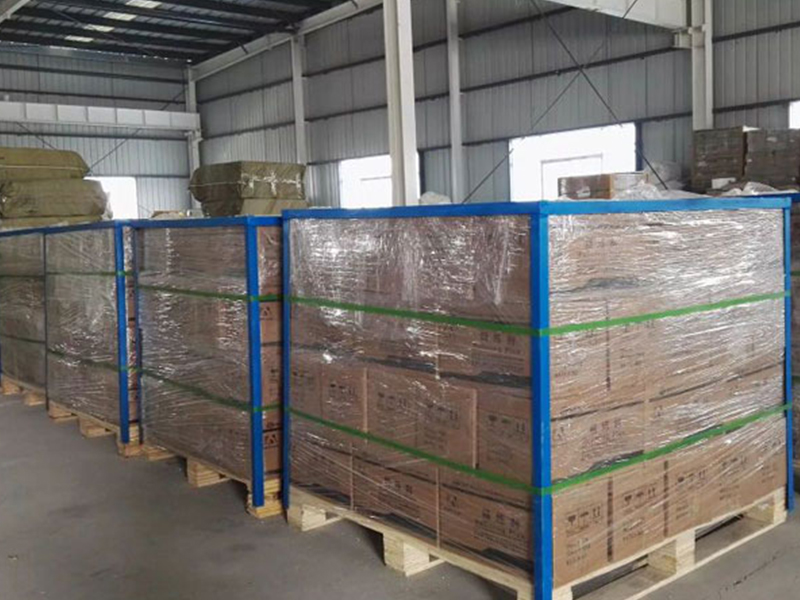
Instructions:
| Type | Advantages | Instructions |
| 3RF,6RF,9RF | 1. Good liquidity, good performance in degassing and deslagging 2. Superior purification, little pollution, little dosage, low cost 3. Continuous using will effectively prevent oxide accumulation in the furnace’s inner surface 4. Easy separation of aluminum and slag 5. 6RF is environmental with no irritative smell, and no damage to health. |
Remove packaging, and put flux into the spray equipment, flux goes through the spray jar with N2 or Ar gas as carrier, spraying evenly two times to molten metal. Make sure the nozzle outlets as close to the bottom layer of molten metal as possible, and move the nozzle back and forth, so that flux is fully in contact with molten aluminum. Then refine the molten metal with N2 or Ar gas in turns at the bottom layer for 20 minutes. After physical and chemical changes in molten aluminum, numerous small bubbles with oxidized slag separation are formed. The bubbles carrying hydrogen atoms slowly rise up and float out, so as to achieve the degassing and deslagging purpose of purification. |
| 420RF,560RF | 1. With little sodium, non-poison, and peculiar smell-free, makes no effect on strontium modifying 2. Good liquidity, good performance in degassing and deslagging 3. Superior purification, little pollution, little dosage, low cost 4. Continuous using will effectively prevent oxide accumulation in the furnace’s inner surface 5. Easy separation of aluminum and slag. |
Remove packaging, flux goes through the spray jar with gas as a carrier, sprayed into molten metal. Make sure the nozzle outlets are as close to the bottom layer of molten metal as possible, and move the nozzle back and forth, so that flux is fully in contact with molten aluminum, to achieve refining purposes. After spraying, take out the slag floating on the surface of molten aluminum. |
| 33SF,66SF | 1. Non-poison and peculiar smell-free, optimum effect for precise casting 2. Good liquidity, good performance in degassing and deslagging 3. Superior purification, little pollution, little dosage, low cost 4. Continuous using will effectively prevent oxide accumulation in the furnace’s inner surface 5. Easy separation of aluminum and slag. |
Remove packaging, flux goes through the spray jar with gas as a carrier, sprayed into molten metal. Make sure the nozzle outlets are as close to the bottom layer of molten metal as possible, and move the nozzle back and forth so that flux is fully in contact with molten aluminum, to achieve refining purposes. After spraying, take out the slag floating on the surface of molten aluminum. |
| 120SF | 1. Mainly composed of an anhydrous potassium compound, with a quick refining effect 2. Effectively remove sodium, lithium, and calcium in molten aluminum-magnesium alloy and aluminum-zinc alloy 3. Remove a variety of non-metallic inclusions such as oxides, carbides, and borides at the same time, together with degassing effort, so as to achieve the purpose of molten aluminum purification. |
1. The dosage is according to the original amount of inclusions, H, Li, Ca, and expected refining standard 2. Remove the basic metal from molten aluminum in the smelting and receiving furnace. 1-1.5kg dosage per ton of molten aluminum, spraying flux will get a better effect of hydrogen, basic metal, and inclusions removing 3. The temperature of the molten aluminum furnace should be 710-745 ℃ 4. Take samples in 3 layers of molten aluminum and make Na、H、Ca and Li analysis, accomplish a non-metallic inclusions removing procedure. |
| 220SF | 220SFis white powdery particles, mainly made of chloride, fluoride, and other elements. With the function of little spreading gas bubbles and active solventia, adjust the speed of chemical reaction, so as to strongly remove Mg element in molten alloy. At the same time, this process also drives out calcium and other metal elements, which brings effective degassing refining, removes inclusions, and helps to minify crystal and such effects. Economically and stably, the slag after processing is incompact and dry, which is easy to take off. | 1. Removing 1 kg Mg in aluminum alloy requires 5kg 220SFin average 2. Calculation: Dosage=(Mg content before damaging– target Mg content)*molten aluminum weight *(5±0.5kg) 3. Analyze a sample of molten aluminum, ascertain metal elements share, and calculate the dosage of 220SF according to the formula 4. Application temperature: 735-745℃ 5. Spray 220SF with nitrogen as a carrier into the furnace in 2 steps and ensure fully contacted. The first step takes half of 220SF and refines for 20-25 minutes, then dross. The second step takes the remaining 220SF, refines for 15-20minutes, and again. When finished, close the furnace door and keep annealing for10 minutes 6. Take samples in 3 layers of molten aluminum and make magnesium analysis, accomplish damaging and refining procedure. |

